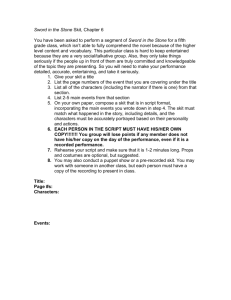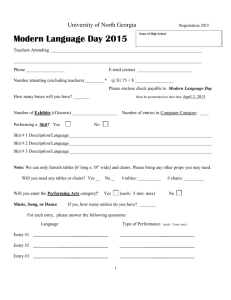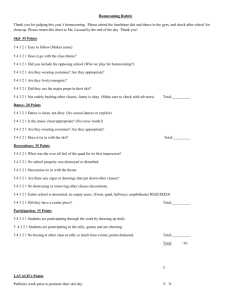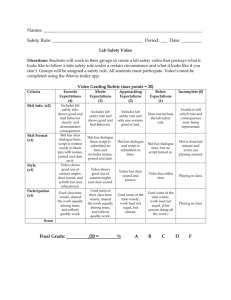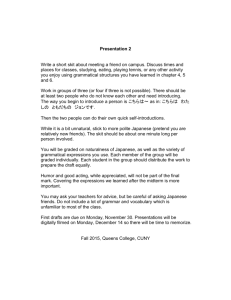4th Grade Home Alone Safety Lesson Plan
advertisement
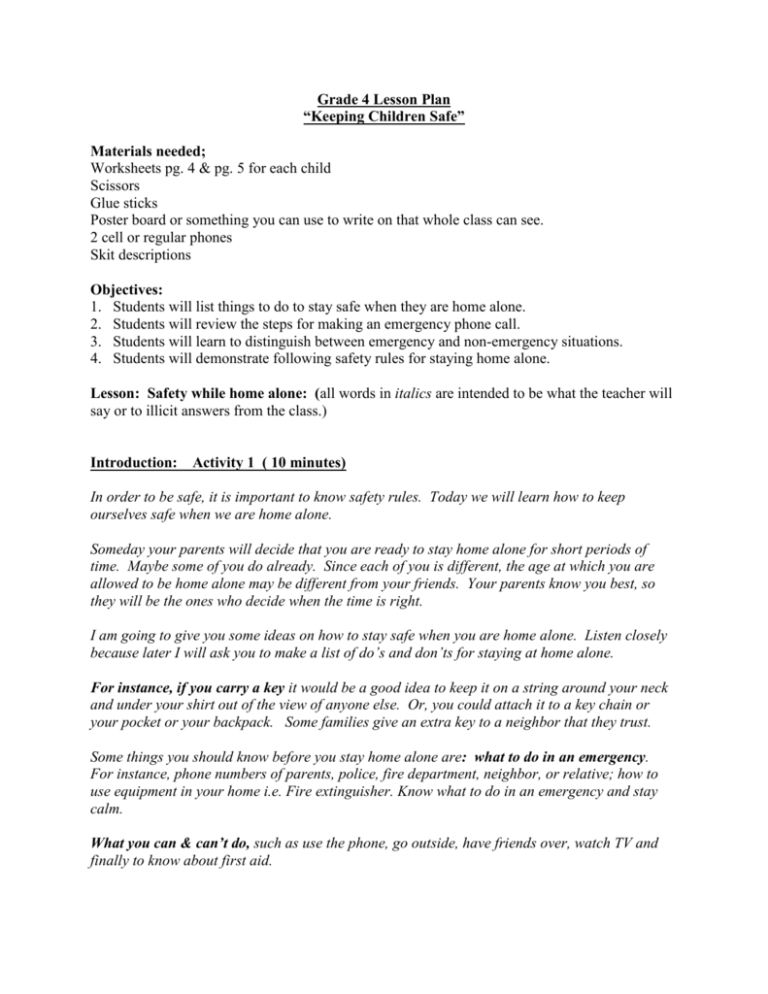
Grade 4 Lesson Plan “Keeping Children Safe” Materials needed; Worksheets pg. 4 & pg. 5 for each child Scissors Glue sticks Poster board or something you can use to write on that whole class can see. 2 cell or regular phones Skit descriptions Objectives: 1. Students will list things to do to stay safe when they are home alone. 2. Students will review the steps for making an emergency phone call. 3. Students will learn to distinguish between emergency and non-emergency situations. 4. Students will demonstrate following safety rules for staying home alone. Lesson: Safety while home alone: (all words in italics are intended to be what the teacher will say or to illicit answers from the class.) Introduction: Activity 1 ( 10 minutes) In order to be safe, it is important to know safety rules. Today we will learn how to keep ourselves safe when we are home alone. Someday your parents will decide that you are ready to stay home alone for short periods of time. Maybe some of you do already. Since each of you is different, the age at which you are allowed to be home alone may be different from your friends. Your parents know you best, so they will be the ones who decide when the time is right. I am going to give you some ideas on how to stay safe when you are home alone. Listen closely because later I will ask you to make a list of do’s and don’ts for staying at home alone. For instance, if you carry a key it would be a good idea to keep it on a string around your neck and under your shirt out of the view of anyone else. Or, you could attach it to a key chain or your pocket or your backpack. Some families give an extra key to a neighbor that they trust. Some things you should know before you stay home alone are: what to do in an emergency. For instance, phone numbers of parents, police, fire department, neighbor, or relative; how to use equipment in your home i.e. Fire extinguisher. Know what to do in an emergency and stay calm. What you can & can’t do, such as use the phone, go outside, have friends over, watch TV and finally to know about first aid. What you can do if you are bored, lonely or scared: find things to do, such as homework, call a friend, chores, hobbies. If something is bothering you have someone to call to talk to about your concern. When you are allowed to stay home alone, it is always important ot talk with your parents abut who to call when you need help. There may be a neighbor, other family member, or friend who is usually home. Finally, how should you handle a phone call or someone who comes to the door? Never tell a person you don’t know that you are home alone. Take a message. Don’t open the door. Talk through the door. Be polite, but firm. Activity 2: (10 minutes) Now that I (we) have talked about some rules, let’s make a list of Do’s and Don’ts for staying home alone. Distribute Worksheets #1 and #2 and scissors and glue sticks. Directions: Cut out each statement and glue the statement in the correct column. Check answers when children are finished. Activity 3: (10 minutes) Discuss phone numbers children should have when they are home alone and when they should be used. 1. Ask the students: Whose phone numbers do you think you need to know if you are home alone? Write the students ideas on a poster board or some type of paper that all can see. Include: Parents’ work phone or number, including cell phone number, where they can be reached. A nearby friend, relative or neighbor. Emergency --- 911. When do you think it is a good idea to call someone on our list? (Call if someone is at the door and won’t go away, if you are frightened, if you have a problem you can’t solve, or if there is a fire.) 2. Help the students distinguish between an emergency and other situations that may require a phone call for help. Ask the students: What are some examples of situations that would require an emergency phone call? (Someone is unconscious. Something is on fire. A car has crashed and someone is bleeding a lot. Someone has fallen and may have broken an arm or let. Someone is trying to break into a house, etc.) Other situations that might be upsetting aren’t emergencies. What are some examples of situations when you might need help? (A dog got in a fight with another dog. A child fell an scraped a knee, etc.) 3. Review the steps in making an emergency phone call: Who remember the emergency phone number? Who knows what you need to say when you dial 911? Augment the students’ responses with the following: Dial 911, the emergency number. When someone answers, speak slowly and clearly. Say: “This is an emergency phone call.” “The address here is__________________. The telephone number here is ____________. The emergency is ______________________.” Wait to hang up the telephone until the person you are talking to hangs up. He or she may need to ask for more information or give you instructions. Using the phone, you could have the children model the correct way to ,ake an emergency phone call. Activity 4: ( 15-20 minutes) 1. So far today we have learned the do’s and don’ts of staying safe while at home alone, whether a situation is an emergency or non-emergency and how to make an emergency phone call. Now let’s do some skits to practice what we have learned. You will pretend to be home alone. I will be one of the people in the skit, but I would like some volunteers to help with our plays. Please raise your hand if you would like to be in a short skit and I will give you a description of your part. You may use the phones in you skit if you would like to. Distribute the Skit Descriptions to volunteers until all the parts have been assigned. Ask the volunteers to quietly read the parts and think about what they will say. Select the first volunteer to come forward. 2. Summarize what you did today. “Your next lesson about safety will be about personal safety in the hall on Tuesday, January 6, 2009 from 3:30 – 4:30 Do’s Don’ts Go straight home after school. Have phone numbers handy. Have friends over without permission. Open door to someone you don’t know. Show people your key. Call someone if you need help. Leave the house without permission. Tell someone you are home alone. Check the house to be sure it’s safe. Follow safety rules Practice unlocking the door. Talk on the phone a long time. Obey the rules your parents have set for you. Use the stove or oven to cook.
